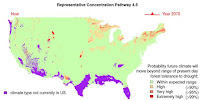North America’s great forests could change in dramatic ways by the end of the century, according to new research.
Subtropical species may colonise the forests of the Cascade mountain range straddling the US-Canada border, the woodlands of the US Gulf Coast may end up looking more like Cuba, and parts of Texas might become home to the hot, dry forests now found in Mexico.
Scientists from Washington State University in Vancouver, Canada, have made a mathematical model of how forests might respond to climate change.
Warmer and wetter
They report in Global Change Biology that as the Pacific northwest of America gets warmer and wetter, the conditions might become more appropriate for forest types seen now in south-eastern China, southern Brazil or sub-Saharan Africa.
In the north-east of the US, the great stands of maple, beech and birch, and the combinations of spruce or fir and pine, will prove vulnerable, they say, to the drought conditions predicted for the second half of the 21st century.
Read more at American Forests Face Major Changes

No comments:
Post a Comment